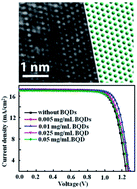High-quality borophene quantum dot realization and their application in a photovoltaic device†
Abstract
Surface modification is an effective strategy to promote charge transport and extraction, reduce the carrier recombination probability, and ultimately improve the performance of perovskite solar cells (PSCs). Borophene is the lightest two-dimensional (2D) layered material, with high carrier mobility and high hardness. In this work, a sonication-assisted liquid-phase preparation technique was developed to prepare borophene quantum dots (BQDs) with uniform size, good dispersion, and high stability. The use of BQDs as a surface passivation agent on the TiO2 layer in an inorganic CsPbI2Br solar cell was presented. It is found that the boron atoms undergo strong interactions with TiO2 and the perovskite, reducing interfacial recombination and forming a cascade energy alignment for effective charge transport. A CsPbI2Br solar cell with a thin BQD interlayer shows high efficiency of 15.31%, whereas the efficiency was 14.24% for the device with no BQDs. The enhancement in efficiency is mainly due to carrier recombination suppression and a decrease in the defect density at the TiO2/CsPbI2Br interface after BDQ treatment. This work demonstrates that high-quality BQDs have great potential to be applied in perovskite solar cells and other optoelectronic devices.



 Please wait while we load your content...
Please wait while we load your content...